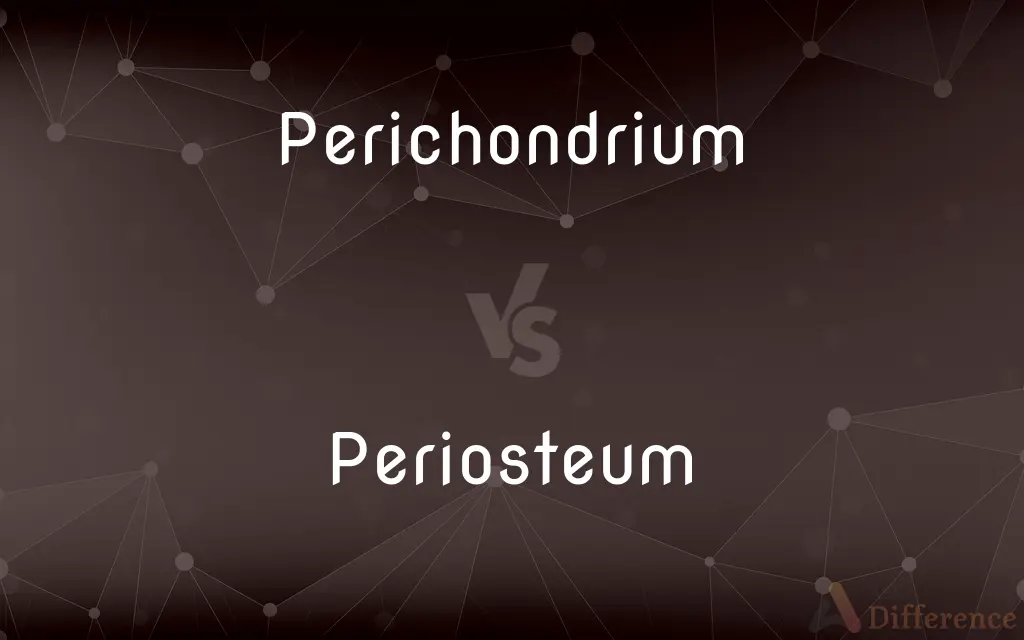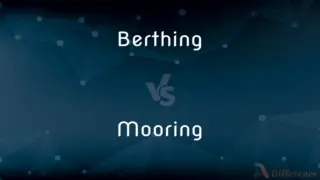Perichondrium vs. Periosteum — What's the Difference?
Edited by Tayyaba Rehman — By Maham Liaqat — Updated on March 20, 2024
Perichondrium surrounds cartilage, aiding in growth and repair, while periosteum covers bones, crucial for bone growth, repair, and nutrient supply.

Difference Between Perichondrium and Periosteum
Table of Contents
ADVERTISEMENT
Key Differences
The perichondrium is a dense layer of connective tissue that envelops cartilage, except at articular surfaces. It plays a vital role in the growth and repair of cartilage, as it contains cells that can differentiate into chondrocytes, the cells responsible for producing the cartilaginous matrix. On the other hand, the periosteum is a fibrous membrane covering all bones except at the joints. It is essential for bone growth, repair, and serves as an attachment point for muscles and ligaments. The periosteum is rich in blood vessels and nerves, providing the bone with necessary nutrients and sensation.
Both the perichondrium and periosteum are involved in the process of appositional growth, where new layers are added to the existing structure, allowing for the growth in diameter of cartilage and bone, respectively. However, their cellular composition and the type of cells they harbor distinguish their specific roles in this process.
While the perichondrium contributes to the formation of new cartilage by differentiating into chondrocytes, the periosteum facilitates bone growth through the activity of osteoblasts, cells that synthesize new bone matrix. This distinction underscores the different mechanisms by which cartilage and bone undergo growth and repair.
The perichondrium's role in cartilage repair is limited due to the avascular nature of cartilage, which slows down the repair process. In contrast, the periosteum's rich vascular supply significantly enhances bone's capacity for repair and regeneration, making it more efficient in healing than cartilage.
The presence of the periosteum is crucial for the attachment of tendons and ligaments to the bone, providing mechanical strength and stability to the skeletal system. The perichondrium, while not directly involved in the attachment of muscles or ligaments, provides structural support and maintains the integrity of cartilage structures within the body.
ADVERTISEMENT
Comparison Chart
Location
Surrounds cartilage
Covers bones
Function
Aids in growth and repair of cartilage
Essential for bone growth, repair, and nutrient supply
Cell Types
Contains cells that differentiate into chondrocytes
Rich in osteoblasts and osteoclasts
Role in Growth
Involved in appositional growth of cartilage
Facilitates appositional growth of bone
Attachment Points
Not directly involved in muscle or ligament attachment
Crucial for the attachment of muscles and ligaments
Compare with Definitions
Perichondrium
A layer of dense connective tissue surrounding cartilage.
The perichondrium of the ear cartilage contributes to its shape and flexibility.
Periosteum
Rich in cells that contribute to bone growth and healing.
Osteoblasts in the periosteum are key for bone repair.
Perichondrium
Facilitates cartilage growth and repair.
Damage to the perichondrium can impair the healing of cartilage injuries.
Periosteum
Essential for the attachment of muscles and ligaments.
Tendons and ligaments attach to bones via the periosteum.
Perichondrium
Generally avascular, affecting repair speed.
The avascular nature of the perichondrium limits rapid cartilage repair.
Periosteum
Highly vascularized, aiding in nutrient delivery.
The periosteum's blood vessels are vital for bone health and regeneration.
Perichondrium
Provides structural support to cartilage.
The perichondrium ensures the integrity and maintenance of cartilage structures.
Periosteum
Involved in appositional bone growth.
The periosteum adds new layers to bones, facilitating growth in diameter.
Perichondrium
Contains precursor cells to chondrocytes.
In cartilage growth, perichondrium cells differentiate into chondrocytes.
Periosteum
The periosteum is a membrane that covers the outer surface of all bones, except at the articular surfaces (i.e. the parts within a joint space) of long bones.
Perichondrium
The perichondrium (from Greek περί, peri, 'around' and χόνδρος, chondros, 'cartilage') is a layer of dense irregular connective tissue that surrounds the cartilage of developing bone. It consists of two separate layers: an outer fibrous layer and inner chondrogenic layer.
Periosteum
A dense layer of vascular connective tissue enveloping the bones except at the surfaces of the joints.
Perichondrium
The fibrous membrane of connective tissue covering the surface of cartilage except at the endings of joints.
Periosteum
The dense fibrous membrane covering the surface of bones except at the joints and serving as an attachment for muscles and tendons.
Perichondrium
(anatomy) a dense layer of fibrous connective tissue surrounding the cartilage of developing bone
Periosteum
A membrane surrounding a bone.
Perichondrium
The membrane of fibrous connective tissue which closely invests cartilage, except where covering articular surfaces.
Periosteum
The membrane of fibrous connective tissue which closely invests all bones except at the articular surfaces.
Common Curiosities
How do perichondrium and periosteum contribute to tissue growth?
Both contribute to appositional growth: the perichondrium by differentiating into chondrocytes for cartilage growth, and the periosteum by housing osteoblasts that form new bone layers.
Can the perichondrium regenerate damaged cartilage effectively?
Its ability is limited due to the avascular nature of cartilage, which slows repair processes.
What makes the periosteum highly efficient in bone repair?
Its rich vascular supply enhances the bone's capacity for repair and regeneration, unlike the limited repair capabilities of cartilage through the perichondrium.
Can injuries to the perichondrium or periosteum affect growth?
Yes, injuries to these tissues can impair the normal growth and repair of cartilage or bone, highlighting their importance in tissue health and maintenance.
Are the cell types in perichondrium and periosteum similar?
No, the perichondrium contains precursor cells to chondrocytes, essential for cartilage formation, while the periosteum is rich in osteoblasts and osteoclasts, crucial for bone formation and remodeling.
Is the thickness of the perichondrium and periosteum uniform across all bones and cartilages?
No, the thickness can vary depending on the location and function of the bone or cartilage, adapting to different mechanical and physiological demands.
What is the main difference between perichondrium and periosteum?
The perichondrium surrounds cartilage and is involved in its growth and repair, while the periosteum covers bones, aiding in bone growth, repair, and providing nutrient supply.
Do perichondrium and periosteum have a role in the attachment of muscles?
The periosteum is crucial for the attachment of muscles and ligaments to bones, providing mechanical strength, whereas the perichondrium does not directly participate in muscle or ligament attachment.
How does the presence of the periosteum affect surgical procedures on bones?
The periosteum's presence necessitates careful surgical techniques to preserve its integrity, as it is crucial for post-surgical bone healing and regeneration.
Are there any conditions that specifically affect the periosteum or perichondrium?
Yes, conditions such as periostitis (inflammation of the periosteum) and chondromalacia (softening of the cartilage) can specifically affect the periosteum and perichondrium, respectively, leading to pain, swelling, and impaired function.
What happens if the perichondrium is damaged?
Damage to the perichondrium can hinder the growth and repair of the underlying cartilage, potentially leading to weakened structures or impaired function.
How do age and disease affect the perichondrium and periosteum?
Aging and certain diseases can diminish the functional capacity of these tissues, impacting their ability to support growth, repair, and overall tissue health.
Share Your Discovery

Previous Comparison
Mall vs. Galleria
Next Comparison
Berthing vs. MooringAuthor Spotlight
Written by
Maham LiaqatEdited by
Tayyaba RehmanTayyaba Rehman is a distinguished writer, currently serving as a primary contributor to askdifference.com. As a researcher in semantics and etymology, Tayyaba's passion for the complexity of languages and their distinctions has found a perfect home on the platform. Tayyaba delves into the intricacies of language, distinguishing between commonly confused words and phrases, thereby providing clarity for readers worldwide.














































